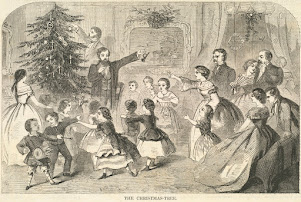The Christmas tree’s origins are a bit murky, with some historians connecting it with pagan tree worship and the Yule log, others with the eighth century St Boniface, while some trace its origins to the “tree of paradise” associated with medieval mystery plays performed on Christmas Eve. The modern Christmas tree got its start with Martin Luther, who supposedly added candles to the decoration of the evergreen he brought into his home. Later resistance to the Christmas tree tradition was strong in Catholic areas and was not because of its supposed pagan connections, but because of its Protestant roots. (The Vatican did not erect a Christmas tree until 1982.)
Queen Charlotte displayed a Christmas tree in England at a party in 1800, and Queen Victoria kept up the tradition, whereupon the upper middle classes avidly copied it in the mid-nineteenth century. Hessian soldiers stationed in Canada set up trees in 1781, but it took a while to move beyond being an ethnic German tradition. In the United States, the first image of a Christmas tree was published in 1863, but it was Godey’s Lady’s Book and its editor Sarah Josepha Hale that get credit for popularizing it. An engraving of a fashionable Victorian family basking in the glow of their tree in 1850 was the first widely-circulated image of a “modern” Christmas tree in America, and within about 20-25 years the Christmas tree tradition had become common in the USA.
There is some magic associated with Christmas trees. I'm thinking of the scene in “The Nutcracker” ballet where the Christmas tree grows enormous, thus signalling the transition to a fantasy world. Premiered in 1892, the ballet clearly reflects the late Victorian-era romanticism associated with the decorated tree.
Anyway, I’ve gathered a few historical engravings of Christmas trees (and a couple of woodcuts). Most of these trees are placed atop a table, which we still do in our house (although we use a very low side table.) It’s much more practical - the presents can go underneath and the cat doesn’t get herself into trouble - and I don’t know why this tradition ever changed. I guess just the usual assumption that bigger must be better. On the other hand, the one woodcut from 1845 suggests an enormous shrubbery. I would assume this one must be outdoors, except that the gentleman isn’t wearing a hat, so I don’t know.
Of course, these prints don’t capture the wonderful colors of a Christmas tree (let alone the scent), but I do like the way some of them show the sparkle and glow, with white carved out all around the trees and their delicate branches. I do love Christmas trees!
Christmas Tree, wood block print from Illustrated London News, Dec. 27, 1845 (Image from The Social Historian);
The Christmas Tree, engraving from Godey’s Lady’s Book, Dec. 1850 (Image from Wikimedia Commons);
The Christmas Tree, wood engraving by Winslow Homer from Harper’s Weekly, Dec. 25, 1858 (Image from Boston Public Library);
F.A.O. Schwartz advertisement, wood block print, 1898 (Image from ebay).]






No comments:
Post a Comment